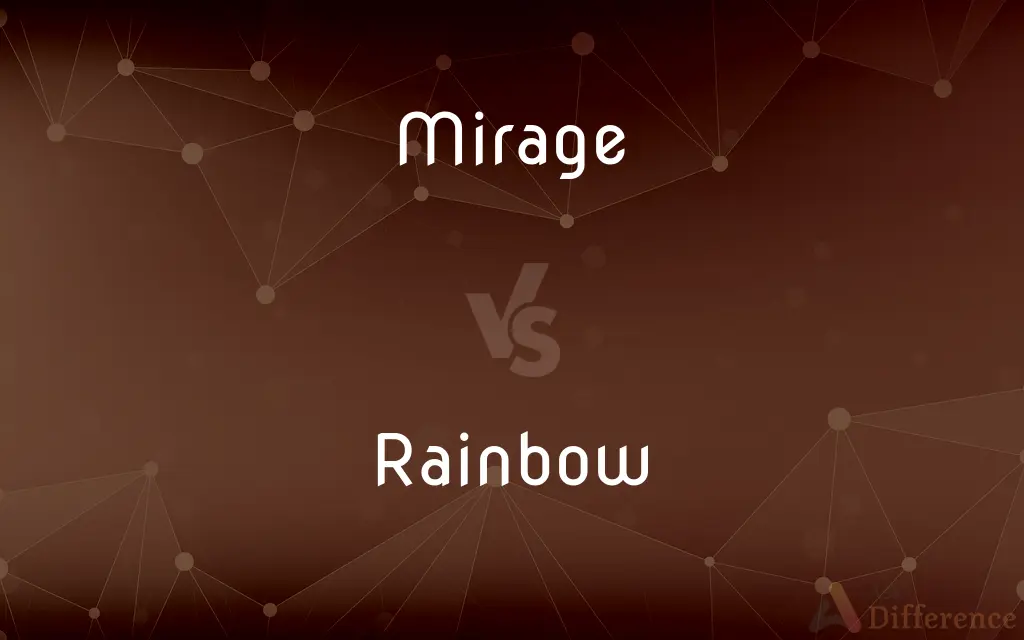Mirage vs. Rainbow — What's the Difference?
By Fiza Rafique & Urooj Arif — Updated on March 29, 2024
A mirage is an optical illusion caused by the refraction of light, often in hot deserts, while a rainbow is a meteorological phenomenon from light refraction in water droplets, creating a spectrum of light in the sky.

Difference Between Mirage and Rainbow
Table of Contents
ADVERTISEMENT
Key Differences
A mirage occurs when light bends (refracts) while passing through layers of air at different temperatures, creating an illusion of water, objects, or the sky on the ground. On the other hand, a rainbow is formed when sunlight is refracted, reflected, and dispersed in water droplets, resulting in a spectrum of light appearing in the sky.
Mirages are often observed in hot deserts or on road surfaces on sunny days, where the ground's intense heat causes layers of air to vary in temperature and density. Whereas, rainbows typically appear opposite the sun's position in the sky, especially after a rain shower, when sunlight passes through moisture in the air.
The types of mirages, including inferior (appearing below the horizon) and superior (above the horizon), depend on the air temperature gradients. Meanwhile, rainbows are categorized by their formation, such as primary, secondary, and supernumerary rainbows, each offering a distinct visual phenomenon based on the light's interaction with water droplets.
Mirages create illusions that can mislead observers into seeing water or objects that are not there, a phenomenon that has been both marveled at and feared. Rainbows, however, are often seen as symbols of hope and beauty, celebrated in many cultures and mythologies.
Despite their differences, both mirages and rainbows serve as fascinating examples of light's interaction with the natural environment, showcasing the complexity and beauty of optical and meteorological phenomena.
ADVERTISEMENT
Comparison Chart
Definition
Optical illusion due to light refraction in air layers of varying temperatures.
Meteorological phenomenon from light refraction and dispersion in water droplets.
Typical Location
Hot deserts, roads.
Sky, opposite to the sun, often after rain.
Causes
Temperature gradients in air layers.
Refraction, reflection, and dispersion of sunlight in water droplets.
Types
Inferior, superior.
Primary, secondary, supernumerary.
Symbolism
Often associated with illusion or mirage.
Symbolizes hope, beauty, and promise.
Compare with Definitions
Mirage
Optical illusion caused by atmospheric refraction.
Travelers in the desert often see mirages of water.
Rainbow
An arc of colors visible in the sky.
After the storm, a beautiful rainbow appeared.
Mirage
Often mistaken for real water bodies.
Thirsty hikers were disappointed by the mirage.
Rainbow
Secondary rainbows are fainter and have reversed colors.
A faint secondary rainbow formed above the primary one.
Mirage
Appears as a distorted or inverted image.
The mirage made the distant car seem to float.
Rainbow
Formed by the refraction of sunlight in water droplets.
The rain and sun combined to create a stunning rainbow.
Mirage
Can occur in any climate but are most common in deserts.
Mirage sightings are frequent on hot summer roads.
Rainbow
A symbol of hope and promise.
Rainbows are often seen as signs of renewal.
Mirage
Created by temperature differences in air layers.
The heat caused a shimmering mirage on the highway.
Rainbow
Can appear as a full circle from high vantage points.
Pilots sometimes report seeing circular rainbows.
Mirage
A mirage is a naturally-occurring optical phenomenon in which light rays bend via refraction to produce a displaced image of distant objects or the sky. The word comes to English via the French (se) mirer, from the Latin mirari, meaning "to look at, to wonder at".Mirages can be categorized as "inferior" (meaning lower), "superior" (meaning higher) and "Fata Morgana", one kind of superior mirage consisting of a series of unusually elaborate, vertically stacked images, which form one rapidly-changing mirage.
Rainbow
A rainbow is a meteorological phenomenon that is caused by reflection, refraction and dispersion of light in water droplets resulting in a spectrum of light appearing in the sky. It takes the form of a multicoloured circular arc.
Mirage
An optical phenomenon that creates the illusion of water, often with inverted reflections of distant objects, and results from distortion of light by alternate layers of hot and cool air. Also called fata morgana.
Rainbow
An arc of spectral colors, usually identified as red, orange, yellow, green, blue, indigo, and violet, that appears in the sky opposite the sun as a result of the refractive dispersion of sunlight in drops of rain or mist.
Mirage
Something illusory or insubstantial.
Rainbow
A similar arc or band, as one produced by a prism or by iridescence.
Mirage
An optical phenomenon in which light is refracted through a layer of hot air close to the ground, often giving the illusion of a body of water.
Optical illusion
Fata Morgana
Rainbow
A graded display of colors.
Mirage
(figuratively) An illusion.
Rainbow
An illusory hope
Chasing the rainbow of overnight success.
Mirage
(transitive) To cause to appear as or like a mirage.
Rainbow
A diverse assortment or collection.
Mirage
An optical effect, sometimes seen on the ocean, but more frequently in deserts, due to total reflection of light at the surface common to two strata of air differently heated. The reflected image is seen, commonly in an inverted position, while the real object may or may not be in sight. When the surface is horizontal, and below the eye, the appearance is that of a sheet of water in which the object is seen reflected; when the reflecting surface is above the eye, the image is seen projected against the sky. The fata Morgana and looming are species of mirage.
By the mirage uplifted the land floats vague in the ether,Ships and the shadows of ships hang in the motionless air.
Rainbow
A multicoloured arch in the sky, produced by prismatic refraction of light within droplets of rain in the air.
Mirage
An optical illusion in which atmospheric refraction by a layer of hot air distorts or inverts reflections of distant objects
Rainbow
Any prismatic refraction of light showing a spectrum of colours.
Mirage
Something illusory and unattainable
Rainbow
(often used with “of”) A wide assortment; a varied multitude.
A rainbow of possibilities
Rainbow
(figurative) An illusion; a mirage.
Many electoral promises are rainbows, vanishing soon after poll day.
Rainbow
(baseball) A curveball, particularly a slow one.
Rainbow
(poker slang) In Texas hold 'em or Omaha hold 'em, a flop that contains three different suits.
Rainbow
A person within the LGBT community.
Oh look, the rainbow came back.
Rainbow
Made up of several races or ethnicities, or (more broadly) of several cultural or ideological factions.
Rainbow
(attributive) LGBT.
Rainbow
Composed entirely of different suits.
Rainbow
Of or pertaining to rainbow tables.
Rainbow attack
Rainbow
(transitive) To brighten with, or as with, a rainbow; to pattern with the colours of the rainbow.
Rainbow
(intransitive) To take the appearance of a rainbow.
Rainbow
(climbing) In climbing gyms where the rocks to climb are colored to indicate suggested climbing routes, to climb rocks of different colors, thereby ignoring such routes.
Rainbow
A bow or arch exhibiting, in concentric bands, the several colors of the spectrum, and formed in the part of the hemisphere opposite to the sun by the refraction and reflection of the sun's rays in drops of falling rain.
Rainbow
An arc of colored light in the sky caused by refraction of the sun's rays by rain
Rainbow
An illusory hope;
Chasing rainbows
Common Curiosities
What causes a mirage?
Mirages are caused by the refraction of light due to temperature gradients in the air.
Are mirages real water bodies?
No, mirages are optical illusions and do not represent real water bodies.
Can mirages appear at night?
Yes, mirages can appear at night, caused by artificial lights and temperature differences, though they are less common.
How is a rainbow formed?
A rainbow is formed when sunlight is refracted, reflected, and dispersed in water droplets, creating a spectrum of light.
What scientific principles explain mirages and rainbows?
The scientific principles of light refraction, reflection, and dispersion explain both mirages and rainbows.
What is the difference between a primary and secondary rainbow?
A primary rainbow is brighter with red on the outer edge, while a secondary rainbow is fainter and has its colors reversed.
Can everyone see the same rainbow?
While the rainbow itself is a physical phenomenon, each observer sees it differently due to their unique perspective and position relative to the light source and water droplets.
Is it possible to reach the end of a rainbow?
No, it's not possible to reach the end of a rainbow because it's an optical phenomenon that moves with the observer's perspective.
Why do rainbows have distinct colors?
Rainbows have distinct colors because water droplets disperse sunlight into its component colors at different angles.
How have mirages and rainbows been interpreted in mythology?
Both phenomena have rich interpretations in mythology, often seen as omens, bridges to the divine, or symbols of hope and promise.
Do mirages only occur in deserts?
While common in deserts, mirages can occur in any climate where conditions create significant air temperature gradients.
What is a supernumerary rainbow?
A supernumerary rainbow is a type of rainbow that appears as additional, faint arcs inside the primary rainbow, caused by wave interference.
Are double rainbows common?
Double rainbows, consisting of a primary and secondary rainbow, are relatively common but depend on the right atmospheric conditions.
Can mirages be predicted?
Predicting specific mirages is difficult due to the need for precise atmospheric conditions, though they are more likely in certain climates and situations.
How do atmospheric conditions affect mirages and rainbows?
Atmospheric conditions such as temperature, humidity, and the presence of water droplets are crucial for the formation of both phenomena.
Share Your Discovery

Previous Comparison
Porridge vs. Crowdie
Next Comparison
Courage vs. ValorAuthor Spotlight
Written by
Fiza RafiqueFiza Rafique is a skilled content writer at AskDifference.com, where she meticulously refines and enhances written pieces. Drawing from her vast editorial expertise, Fiza ensures clarity, accuracy, and precision in every article. Passionate about language, she continually seeks to elevate the quality of content for readers worldwide.
Co-written by
Urooj ArifUrooj is a skilled content writer at Ask Difference, known for her exceptional ability to simplify complex topics into engaging and informative content. With a passion for research and a flair for clear, concise writing, she consistently delivers articles that resonate with our diverse audience.
















































